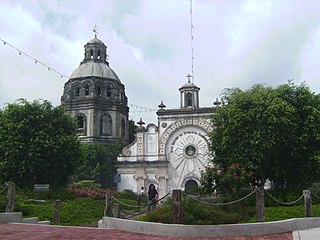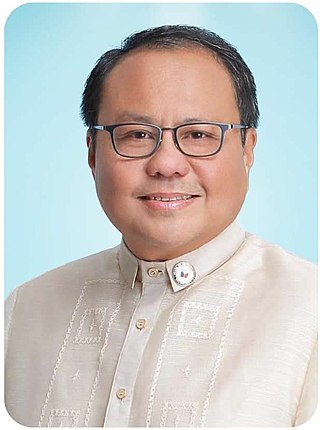
Pampanga, officially the Province of Pampanga (Kapampangan: Lalawigan ning Pampanga; Ilocano: Probinsia ti Pampanga; Pangasinan: Luyag/Probinsia na Pampanga; Tagalog: Lalawigan ng Pampanga, is a province in Central Luzon in the Philippines. Lying on the northern shore of Manila Bay, Pampanga is bordered by Tarlac to the north, Nueva Ecija to the northeast, Bulacan to the east, Manila Bay to the central-south, Bataan to the southwest and Zambales to the west. Its capital is the City of San Fernando, the regional center of Central Luzon. Angeles City is the largest LGU, but while geographically within Pampanga, it is classified as a first-class, highly urbanized city and has been governed independently of the province since it received its charter in 1964.

Nueva Ecija, officially the Province of Nueva Ecija, is a landlocked province in the Philippines located in the Central Luzon region. Its capital is the city of Palayan, while Cabanatuan, its former capital, is the largest local government unit (LGU). Nueva Ecija borders, from the south clockwise, Bulacan, Pampanga, Tarlac, Pangasinan, Nueva Vizcaya and Aurora. The province is nationally known as the Rice Granary of the Philippines, producing the largest rice yield in the country.

Angeles, officially the City of Angeles, is a 1st class highly urbanized city in the Central Luzon region of the Philippines. According to the 2020 census, it has a population of 462,928 people.

San Fernando, officially the City of San Fernando, is a 1st class component city and capital of the province of Pampanga, Philippines. According to the 2020 census, it has a population of 354,666 people.

Bacolor, officially the Municipality of Bacolor, is a 3rd class municipality in the province of Pampanga, Philippines. According to the 2020 census, it has a population of 48,066 people.

Magalang, officially the Municipality of Magalang, is a 1st class municipality in the province of Pampanga, Philippines. According to the 2020 census, it has a population of 124,188 people.
The Kapampangan people, Pampangueños or Pampangos, are the sixth largest ethnolinguistic group in the Philippines, numbering about 2,784,526 in 2010. They live mainly in the provinces of Pampanga, Bataan and Tarlac, as well as Bulacan, Nueva Ecija and Zambales.

Pedro Abad Santos y Basco was a Filipino Marxist politician. He founded the Partido Sosyalista ng Pilipinas (PSP) or Philippine Socialist Party in 1932. He ran for several local elections but never won. He also ran for president in the 1941 Philippine presidential election, but later withdrew, weeks before the election. Luis Taruc of the Hukbalahap Rebellion was under his tutelage and was his right-hand man.

Ladislao Diwa y Nocon was a Filipino patriot who was among the founders of the Katipunan that initiated the Philippine Revolution against Spain in 1896.
The legislative districts of Pampanga are the representations of the province of Pampanga and the highly urbanized city of Angeles in the various national legislatures of the Philippines. At present, the province and the city are represented in the House of Representatives of the Philippines by its four congressional districts.

Joaquín González was a Filipino politician and a member of the Malolos Congress that wrote the Malolos Constitution, the first Philippine constitution, after the country declared independence from Spain in 1898. He was one of two elected delegates representing the province of Pampanga, the other being José Rodríguez Infante. Along with Felipe Calderón y Roca, the main author of the constitution, Dr. González was on a committee that debated over each article of the charter from October 25 to November 29, 1898.

Jose "Joe" Bulaon Lingad, also known by his initials JBL, was a Filipino lawyer and politician who served as governor of Pampanga from 1948 to 1951 and representative of Pampanga's 1st district from 1969 to 1972. He also became commissioner of the Bureau of Internal Revenue and Bureau of Customs then subsequently secretary of the Department of Labor and Employment. He is one of the victims of the Martial law at the hands of Ferdinand Marcos in 1980.

The Archdiocese of San Fernando is the archdiocese of the Latin Church of the Catholic Church in Pampanga, Philippines which has territorial jurisdiction over the whole province of Pampanga and Angeles City. The archdiocese is also the metropolitan see of the ecclesiastical province of the same name, which also include three dioceses of its surrounding provinces of Bataan, Zambales, and Tarlac. The cathedral church and seat of the archdiocese is the Metropolitan Cathedral of San Fernando (Pampanga). The Virgin Mary, under the title Virgen de los Remedios, is the principal patroness.

Pablo John "PJ" Fiel Garcia is a Filipino lawyer and politician. He is a member of the National Unity Party and the One Cebu party

Jose Casten Zulueta was a Filipino lawyer and politician. He served as Senate President for a brief period in 1953.

Francisco Tongio Liongson was a Filipino medical doctor and politician.
The Philippine Law School (PLS), founded in 1915, is a law school in the Philippines. It formerly served as the college of law of National University.

Pedro Tongio Liongson was a member of the Malolos Congress which wrote the constitution of the First Philippine Republic in 1899 and served as First Director of Military Justice in the Republic's army during the Philippine–American War of 1899–1901. A trained lawyer and judge, Col. Liongson figured in and left his mark on a number of historic events in the Philippines.
Casto Jurado Alejandrino was a Filipino peasant leader and commander of the Hukbalahap. He was the Hukbalahap's vice-commander, second only to its Supremo, Luis Taruc. Alejandrino was one of the few supporters of the Hukbalahap that were also landlords, coming from the Alejandrino family which included former revolutionary general Jose Alejandrino.
Pampanga in the Philippine Revolution remained almost wholly loyal to Spanish suzerainty, with only few noble Kapampangan families defecting to the Katipunan. Kapampangan involvement in defending Spanish interests began when the Revolution broke out, with many freemen enlisting in Spanish forces. However, Tagalog rebels would eventually infiltrate the province and begin a campaign of terrorism. Once Spain lost the Battle of Manila Bay, Spanish forces in Pampanga retreated to Macabebe and awaited their return to Spain. Republican forces would raze and loot Kapampangan towns for their cooperation with Spanish forces. To revenge their losses, many Kapampangans would enlist with the Americans to defeat the Philippine Republic.
















